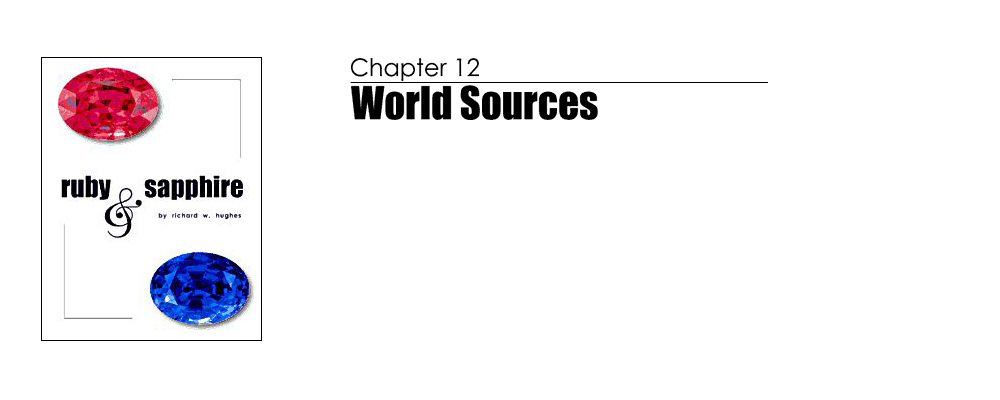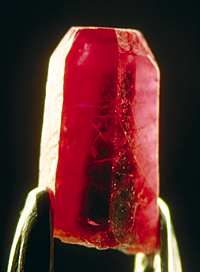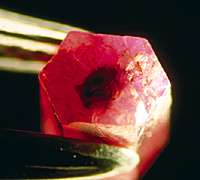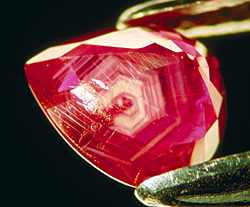|
Namsèka rubies: Salt of the earth? One Burmese locality that has received scant mention is that of Namsèka. Located 24 km (15 miles) southwest of Mainglôn (which is just south of Mogok), in the narrow valley of the Nampai, it was described by Fritz Noetling in 1891. At the time of his visit the deposit had apparently not been worked for some time. The exact occurrence is said to be less than 1 km northwest of the small village of Namsèka. According to Noetling, the first samples of ruby brought to the attention of the Government of Burma were of high quality and were provided by Lieutenant Daly, Superintendent of the Northern Shan States. However, Noetling spent three full days with twelve coolies working the deposit, and found not even a single fragment of ruby. Only some dark purple spinels turned up. According to a story told to Noetling… When the Thibaw Sawbwa sent one of his officials to Namsèka to get samples of good stones from the mines, none could be procured. The man therefore went over to Mogôk, where he purchased the stones which were handed over to the Sawbwa as "Namsèka rubies. Noetling told the local Sawbwa about his doubts regarding ruby occurring at Namsèka. The Sawbwa proceeded to produce a plate of stones which included both rubies and other gems, with the rubies matching those of Lieutenant Daly perfectly.
In the end, Noetling had to conclude that he just wasn't sure about rubies at Namsèka. It was possible that the mine was originally salted in an attempt to sell the mining rights, but it was equally possible that the rubies occurred in irregular concentrations which would be uncovered only by sustained work at the site. Since Noetling's report in 1891, nothing more has been heard of the rubies of Namsèka… |
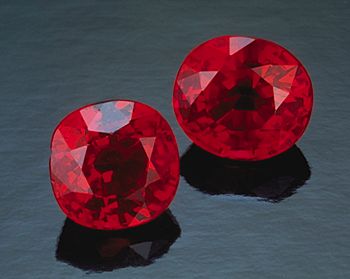 Figure 48. Möng Hsu rubies revitalized Burma's moribund gem industry when they first hit world gem markets in the early 1990s. The above two stones, weighing 2.59 ct total, are superb examples of just what all the fuss was about. (Photo: © 1994 Tino Hammid; stones: Amba Gem Corp., New York)
Figure 48. Möng Hsu rubies revitalized Burma's moribund gem industry when they first hit world gem markets in the early 1990s. The above two stones, weighing 2.59 ct total, are superb examples of just what all the fuss was about. (Photo: © 1994 Tino Hammid; stones: Amba Gem Corp., New York)
Other Burma corundum localities
Gem-quality rubies and sapphires are found in a number of other areas, all of which are in upper Burma. These include:
- Sagyin, near Mandalay, where poor-quality rubies have been mined from the marble quarries.
- Thabeitkyin, along the Irrawaddy river, west of Mogok, for ruby.
- Yet-Kan-Zin-Taung, 50 miles (80 km) from Mandalay along the Mogok road, for ruby.
- Namsèka, south of Mainglôn (Möng Long), for ruby.
- Naniazeik, Myitkyina district, Kachin State, for ruby.
- Möng Hsu, Southern Shan States, for ruby.
- Möng Hkak, Southern Shan States, for sapphire.
- Nawarat (Pyinlon), Shan State, for ruby.
- Namhsa, 15 km north of Nawarat (Shan State), for ruby.
Sagyin Hills
In the Sagyin Hills, just 26 km north of Mandalay and 3.2 km from the Irrawaddy river, rubies were once obtained from the detritus of clay-filled hollows and fissures in the crystalline limestones. Such hollows were said to yield sapphires, spinels and amethysts, in addition to rubies (Penzer, 1922). This locality is famed for fine marble, as well.
Apparently the mines had been worked for many years. King Mindon Min was said to have obtained Rs30,000 worth of rubies in one month from an old cave-working and pit in the adjoining alluvium, which were called the Royal Loo 18 (Holland, 1898).
About 1870, the mines were under the supervision of a German engineer named Bredemeyer, who stated that stones were best when the detritus was of a yellow color. In 1873, Captain G.A. Strover, described the Sagyin rubies in the Indian Economist as being lighter in color that those from Mogok (Penzer, 1922).
According to Penzer (1922) and Chhibber (1934), a Sir Henry Hayden inspected the tract in 1895. He found the rocks to be gneisses and schists, with bands of crystalline limestone in them. The latter were considerably altered, and contained numerous minerals, including spinel and ruby overlying the crystalline limestone. Moisture moved through the joints between the limestone and surrounding rocks, dissolving the limestone and creating fissures and hollows. These open spaces later trapped the more resistant and insoluble clayey materials, including rubies.
At the time that Penzer described the deposit (1922), little work was being done and it appears that little work has been done since.
In May of 1996, the author visited Sagyin, which is mainly worked for marble. A few workers were digging into the marble for gems, but apparently having little luck.
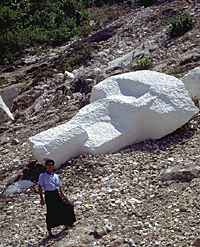 |
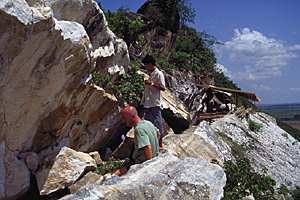 |
Figure 49. Sagyin is famous for marble, as evidenced by the large block roughly formed for a Buddha carving. At the time of the author's visit in May, 1996, a few people were also digging for rubies. (Author's photos) | |
|
Buying at the source Before the discovery that Burmese rubies could be heat treated, the presence and relative abundance of fluid fingerprints and feathers was useful in determining whether or not a particular ruby originated from Burma. The author recalls examining large numbers of suspected Burmese rubies brought for examination. A quick look in the microscope, however, revealed numerous fingerprints and feathers. Looks of anticipation turned to frowns when told that the only thing "Burmese" about the gems were the nationality of the sellers. In the same vein, a story regarding an acquaintance comes to mind that speaks volumes about the efficiency of modern transportation. This gentleman journeyed all the way from Bangkok to Peshawar, Pakistan for the purpose of buying Afghan gemstones. He bought several lots of rubies from Afghan refugees who had just crossed the border, eager to raise cash for purchasing weapons to drive the Russian infidels out of their homeland. Back in Bangkok I examined his purchases and was forced to relay the information that his journey had been for naught. Most of the rubies were from Thailand. |
Thabeitkyin (Thabeikkyin)
Burma's Thabeitkyin area has received little notice.The following is based on the 1938 report of U Khin Maung Gyi (Gyi, 1938).
Thabeitkyin township is located on the Irrawaddy river north of Mandalay. In former years, access to Mogok was via river steamer to Thabeitkyin.
From there, the road heads east to Mogok, some 60 km away (today a road heads directly to Mogok from Mandalay).
Rubies at Thabeitkyin were reportedly mined as early as the 1870s, though no valuable stones were found until the reign of King Thebaw [1878–1885]. U Yauk, from Ye-nya-u village, is said to have found a ruby the size of a hen's egg.19 Since all large finds were considered the property of the king, the stone was duly delivered to the palace. This was how the king came to learn of rubies at Thabeitkyin, and from that point on a ruby tax was levied on the villagers of the area.
Old mining sites at Thabeitkyin are west of Wabyudaung, at Twindawgyi, Kyaukpya, Ohnbaing and Ye-nya-u Pandwin. In the 1930s, ruby was found at Kyet-saung-taung, Zaneechaung and Nyaungbintha. Kyet-saung-taung lies roughly 5 km southwest of Wabyudaung.
In addition to rubies, blue and star sapphires have been recovered from Thabeitkyin.
In recent years, several spots in the Thabeitkyin tract have been worked, mainly for spinel. Bangkok gemologist, Mark Smith, visited a locality known as "One Cock Hill" in 1998, where people were digging mainly spinels.
Yet-Kan-Zin-Taung
Corundum is said to occur at Yet-Kan-Zin-Taung village, which lies on the east side of the Mandalay-Mogok road, some 50 miles (80 km) towards Mogok, near the village of Let-Pan-Hla (U Hla Win, pers. comm., 27 June, 1994). Good-quality ruby is said to occur along with red spinels. The locality is also notable for its production of red star spinels. Mining is said to be difficult due to the rocky nature of the soil.
Naniazeik (Nanyaseik, aka Namya)
In the early 1890s, ruby was found at Naniazeik, Myitkyina district, Kachin State. Naniazeik lies some 80 km west of Myitkyina and 19 km west of Kamaing. According to Penzer (1922), Warth examined the deposit, in 1895. "He [Warth] stated that rubies, sapphires, and spinels were obtained from the detritus afforded by the disintegration of crystalline limestones surrounded by intrusive masses of granite."
The most complete description of this occurrence is that of Chhibber (1934), with Tanatar (1907), Bleeck (1908) and Hertz (1912) also weighing in with reports. Chhibber (1934) examined the deposit in the early 1890s. He described the major localities as being in the neighborhood of Mawthit and Marrawmaw. Shan women would wash for gold, while the males would work for rubies and other gems. In addition to ruby, spinel is also found. Their color was said to vary from a near-opaque, dark green to a bright, translucent red, with the latter color being rare. Metamorphosed limestones were thought to be the source of origin for both the rubies and spinels.
The author is unaware of anything published on this deposit since Chhibber in 1934. In 1996 and 1997, the author visited the village of Naniazeik. Inquiries were made about mining in the area, but little work was apparently taking place. In late 1997, gemologists George Bosshart and Thet Oo visited Naniazeik, where they were shown corundum rough, mostly pink and blue, with some small reds. Diamonds are also found in the area. A restaurant owner stated to them that the alluvial deposits north of the village were more productive than those to the south. (G. Bosshart, pers. comm., 21 July, 1999)
|
||||||||
Möng Hsu (Shan: Maing Hsu)
In 1991, U Tin Hlaing first reported on the occurrence of ruby at Möng Hsu. The following is based largely on his reports (Hlaing, 1991, 1993a, 1994).
Rubies at Möng Hsu were said to have been discovered by a local resident who had worked as a miner at Mogok. While bathing in the Nam Nga stream, which runs near the town of Möng Hsu, he stumbled across rubies among the pebbles on the banks. Thus began the most recent of Burma's ruby rushes. Fortune seekers flocked to the area and the population swelled from 8000, to over 30,000 at the peak of mining activity. This tapered off, however, as between April and June, 1993 the price for Möng Hsu ruby rough dropped by half (Hlaing, 1994).
Möng Hsu is one day's drive northeast of Taunggyi, (173 km by road; 83 km as the crow flies). It lies between the Nam Pang and Salween rivers. Typical of many areas in Burma's Shan States, the population of the Möng Hsu area consists of Shans in the valleys, with hill tribes (Palaungs at Möng Hsu) living at higher elevations. These Palaungs were involved in tea cultivation before the discovery of ruby (Hlaing, 1994).
Mining was initially restricted to valley alluvials, but later moved into the in-situ marble deposits in the surrounding limestone hills. Minerals associated with the ruby are flattened quartz, green tourmaline, red-brown garnet, staurolite, pyrite, and radiating acicular tremolite (Hlaing, 1993a).
In early 1994, the Burmese government was said to be considering joint ventures with foreign firms for the mining of ruby at Möng Hsu (Ted Themelis, pers. comm., Feb., 1994). Similar noises were made in 1989–90 about allowing foreigners to mine at Mogok, but turned out to be nothing but a pipe dream.
Much of the material mined at Möng Hsu makes its way into Thailand, particularly through Mae Sai. Initially the deposit has shown great promise, so much so that by the early 1990s, Möng Hsu was supplying the world with as much as 90% or more of all facet-grade ruby in sizes of 2.0 cts. and under.
But this material is not without its problems. Most of the Möng Hsu ruby is heavily fractured. Thai burners combat this by heating the stones in the presence of flux (typically borax), which heals the fractures shut. Unfortunately, the fact that this treatment was performed on virtually all rubies from this deposit was not disclosed to buyers by sellers in Thailand, leaving these customers feeling literally like they had been "burned." The eventual result was a rejection of these goods by a substantial number of buyers.
Today, this flux-healing treatment is generally known by most buyers, meaning that Möng Hsu rubies fetch prices far less than their fully natural brethren from Mogok. For a full description of the problems with Möng Hsu ruby, see the author's Foreign Affairs: Fracture Healing/Filling of Möng Hsu Ruby.
Characteristics of Möng Hsu (Burma) corundum
Since the discovery of ruby at Möng Hsu, good reports of their characteristics have been published. These are summarized in the following table on Mong Hsu rubies:
Properties of Möng Hsu (Burma) ruby
|
Property |
Description |
|---|---|
|
Color range/ |
Generally medium to deep red. Before heat treatment, crystals display cores of a blue to violet color. Such blue cores are eliminated during heat treatment. Star stones have not been reported. |
|
Geologic |
Found in primary metamorphosed crystalline limestone (marble), as well as secondary deposits derived from the same |
|
Crystal habit |
Well-formed crystals consisting of pyramids/bipyramids terminated by the basal pinacoid. Development of the hexagonal prism is generally slight. |
|
RI & |
RI readings may vary depending upon the area of the crystal tested, with higher RIs found in the crystal center. It has been hypothesized that this is due to higher Cr concentrations in crystal centers. n omega = 1.760–1.770; n epsilon = 1.768–1.778 Bire. = 0.008 to 0.009 |
|
Specific |
3.97 to 4.01 |
|
Spectra |
Visible: Strong Cr spectrum, identical to other natural and synthetic rubies Ultraviolet: Differences were found between the UV spectra before and after heat treatment. Heat-treated specimens showed dramatically increased transmission from 340-280 nm. Infrared: Sharp peaks were recorded at 3189, 3233, 3299, 3310, 3368, 3380, and 3393 wavenumbers. Such peaks have not been found in rubies from other sources. |
|
Fluorescence |
UV: Moderate to very strong red (LW stronger than SW) |
|
Other features |
Not reported |
|
Inclusion types |
Description |
|
Solids |
Many Möng Hsu rubies possess no solid inclusions. When they are found, they tend to occur near the surface, making them rare in cut gems. Those identified to date include the following: • Apatite (Smith & Surdez, 1994) |
|
Cavities |
• Secondary fluid inclusions (healed fractures) are common, in a variety of patterns. Many of these result from flux-assisted healing of fractures during heat treatment. See the author's Foreign Affairs article for more information on this treatment. |
|
Growth zoning |
• Straight angular growth zoning parallel to the crystal faces is present in all specimens. Irregular `treacle'-like swirls in other directions. Zoning can be extremely sharp (use shadowing illumination). |
|
Twin |
• Polysynthetic glide twinning on the rhombohedron {1011} is often present |
|
Exsolved solids |
• Clouds of tiny exsolved inclusions of unknown identity are common. As with all exsolved inclusions, these follow the growth structure of the crystal, and are concentrated relative to the original impurity content of the crystal at that stage of growth. |
|
a. Information is based on the published reports of Smith (1995), Smith & Surdez (1994) and Laughter (1993a-b), along with the author's own observations. See the author's Foreign Affairs article for more information on this material. |
|
Möng Hkak
Vague reports of a Kengtung Stone Tract have existed for years (Halford-Watkins, 1934). In 1993, U Tin Hlaing (1993b) gave specific information on a sapphire deposit in that area. Located in the Southern Shan States, 75 km east of Möng Hsu and just north of Kengtung, sapphires are said to occur in a secondary deposit associated with surrounding metamorphic (schist, gneiss) and igneous (granite, basalt) country rocks. The gems were found near the village of Wai Hpa Fai, 5 km from Möng Hkak, with ethnic Wa mining sapphire from open pits. Möng Hkak sapphires are said to have an average length of 1.5 cm, with gem-quality material being "much smaller (about 0.3 mm in size)" (Hlaing, 1993b). This description of the size of the gem material may be a typographical error, for unless larger material were forthcoming, the deposit would seem to have little potential. Blue-green bi-color sapphires are also said to be found at Möng Hkak (Hlaing, 1993b).
Nawarat & Namhsa
Kane & Kammerling (1992) reported on two additional areas where ruby has been found. Nawarat,20 also known as Pyinlon, lies in the northern Shan State, near the Chinese border; Namhsa is some 15 km north of Nawarat. Mining in this area has apparently been ongoing since 1990. Immediately after the 1991 MGE emporium, a 5.25-ct faceted ruby "of exceptional color and clarity" was shown to Kane & Kammerling. This gem was later christened the Nawarat Tharaphu, and was reportedly cut from a 9.70-ct piece of rough found on April 23, 1990 at Nawarat.
|
Pilgrimage to Mogok Everyone has their own personal Mecca, their own pilgrimage to make. For myself, it has been Burma's Mogok Stone Tract. I waited patiently for over 15 years for this door to open. In April-May of 1996, it happened. Mogok was everything I expected, and more. The town itself is no longer a small village of a few thousand inhabitants, but a bustling city. Today, the entire district probably contains 300,000–500,000 inhabitants. These consist of Burmese and Shan (Buddhist), Nepalese Gurkhas (Hindu), Lisu (Christian and Animist), along with a smattering of Muslims, Sikhs and those of Eurasian origin. The region's population has swelled tremendously in recent years, following the Burmese government's liberalization of the gem trade. Today, urban Mogok encompasses everything from Myintada in the southwest, to On Bin, in the northeast. One valley over, the town of Kyatpyin has merged with Kathé. Many areas, which were once distinct villages, are now simply urban appendages of either Mogok or Kyatpyin. During my trips, in addition to Mogok/Kyatpyin, I visited mines at Ah Chauk Taw, Chaunggyi, Dattaw, Inn Chauk, Inn Gaung, Lay Oo, Lin Yaung Chi, On Bin, Ongaing, Pingu Taung, Pyaung Gaung, Shwe Pyi Aye, Thurein Taung, and Yadanar Kaday-kadar. Today, the easily-accessible valley alluvials have been exhausted, and thus mining has largely moved to hillside and hard-rock deposits. During the author's five days in Mogok, not a single twinlon was seen, with the only valley mines observed consisting of lebins. Hard-rock mining takes place at a number of localities, including Dattaw, Thurien Taung, and Lin Yaung Chi, among others. Perhaps the most exciting part of my journey was a visit to a loodwyin at Thurien Taung. The indefatigable Dr. Saw Naung Oo, who resides in nearby Kyauk Pyatthat, guided us through thin cracks deep inside the mountain. These represented solution cavities and fissures within the marble, and provide places for gems to concentrate. Small wooden channels have been constructed to carry the overburden and byon out for washing. While most loos consist of narrow cracks, in places these widen out into limestone caverns. Dr. Saw Naung Oo told us of one chamber at Yadanar Kaday-kadar which was nearly as big as a football field. Another fascinating day was spent traveling to Bernardmyo. Transport was Willy's Jeep, ca. 1950, but the road was strictly 19th century ox-cart path. Indeed, while it takes 1.5 hours by jeep, one can walk it in less than six. This gives some idea of the speed of the jeep. Thankfully, while the jeep sometimes carries as many as 20 passengers, ours had only five. Halfway to Bernardmyo is the fascinating Inn Chauk mine, where rubies are pried from beneath towering marble pillars. Due to weathering, such marble outcrops feature a black skin, and are common throughout the Mogok area. At Pyaung Gaung, peridot is obtained by blasting in a peridotite. Bernardmyo itself is a small village inhabited by Chinese and Lisu. Nearby is a cemetery, where tombstones bear mute witness to early trials of British soldiers in this area. Most graves date from 1888–1892. My pilgrimage to Mogok was a dream come true. It is a Mogok tradition that one wishes the owner luck when leaving a mine. Thus, to the people of Mogok I wish them luck. Kyauk gyi, kyauk gaung, yaba zay. Good luck. May the stones you find bring you as much happiness as my visit to Mogok brought me. Mining areas and tradingWhile a variety of stones are found in most deposits, local inquiries revealed that certain areas are famous for a particular variety.
The Mogok area also features several regular gem markets, which have certain specialties and times of operation.
In the past few years, trading in Burma has undergone a revolution. Just four years ago, private gem trading was illegal; today, both rough and cut stones can be freely purchased by foreigners with dollars from licensed traders, with only a 10% export tax to be paid. And most importantly, such licenses are cheap and easy for locals to obtain. Thus, for the first time in over 30 years, private trading and export of gems is both simple and legal. In a land where private business was once the sole province of the tatmadaw (military), these changes are nothing short of remarkable. Make no mistake, the tatmadaw still has their fingers in many pies, but, for the first time in decades, they are allowing others to have a taste, too. |
|||||||||||||||||||||||||||||||||||||||||||||||||||||||||||||||||||||
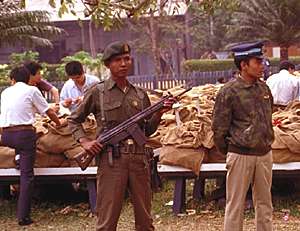 Figure 51. Foreign buyers examine rough jadeite at the 1992 gem emporium at Rangoon's Inya Lake Hotel. Such emporiums were once the only legal way to do business in Burma, but today trading is possible via licensed private gem dealers. (Photo by the author)
Figure 51. Foreign buyers examine rough jadeite at the 1992 gem emporium at Rangoon's Inya Lake Hotel. Such emporiums were once the only legal way to do business in Burma, but today trading is possible via licensed private gem dealers. (Photo by the author)
Future prospects for Burma
Production from Burma's mines has never been great, a fact consistently overlooked by those seeking to exploit the deposits. 21 Although mining methods have improved over the past few years, production remains small. This has pushed prices for Mogok rubies and sapphires to record levels. Prospects for the future appear no better than the past. While it is likely that material remains in the ground waiting to be mined, only a change in government seems destined to bring about a total revitalization of Burma's gem and jewelry industry. In the meantime, other sources, such as Thailand, and recently Vietnam, fill, to a degree, the world's appetite for ruby. This may push away the pangs of hunger, but it does not satisfy the heart's longing for the storied stones of history. Thus the world is forced to wait, with bated breath, for the day when the glowing red stones of Burma will again take their rightful place as the world's premier ruby.
Notes
18. The "Royal Loo" was also mentioned by Brown and Judd (1896), but described it as being at Bobedaung, near Mogok. It seems likely that the name was applied to any deposit that produced a "Royal" ruby.[ return to chapter text ]
19.Rubies the size of "a hen's egg" have been frequently reported in the literature. The author is still waiting to see his first fine specimen of such a size.[ return to chapter text ]
20. Literally "nine gem talisman," which is related to the nine planets of Vedic astrology. Ruby, the gem of the sun, is traditionally placed at the center.[ return to chapter text ]
21. Witness Samuel Chappuzeau, who in 1671 wrote of Burma: "Nothing comes thence but Rubies, and not in so great quantities as is believed, seeing that every year there comes not out to the value of an hundred thousand Crowns, and amongst them you'll very rarely find a Stone of four or five Carrats that is fair." [ return to chapter text ]
Further Reading
- Pigeon's Blood: A Journey to Mogok by R.W. Hughes
- Foreign Affairs: Fracture Healing/Filling of Möng Hsu Rubies by R.W. Hughes & O. Galibert


